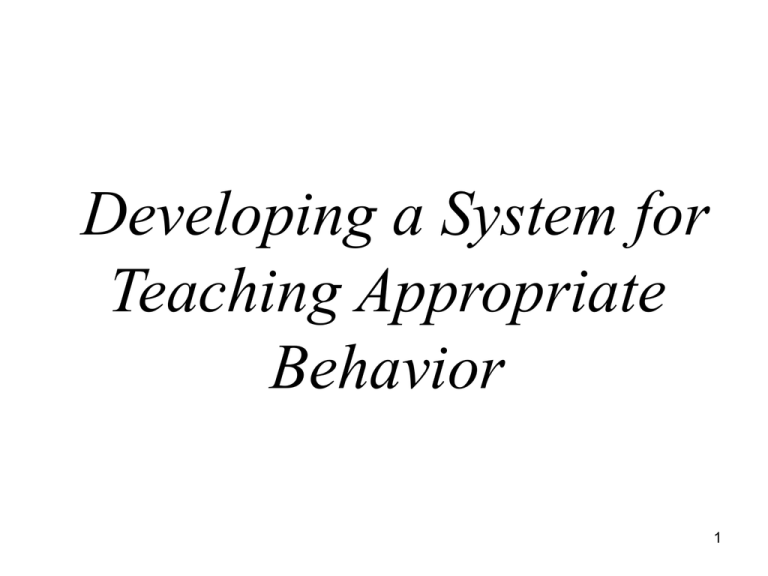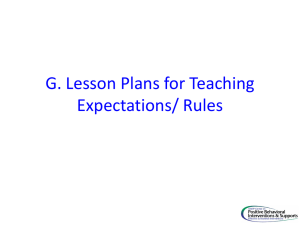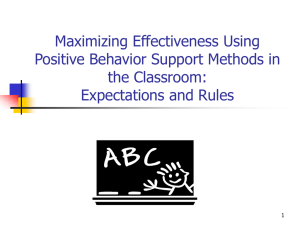Developing a System for Teaching Appropriate Behavior
advertisement

Developing a System for Teaching Appropriate Behavior 1 Objectives • Understand why and how to teach appropriate behavior • Identify how to develop lesson plans for teaching school-wide expectations and rules • Identify how to embed expectations in the curriculum • Explore creative ways to teach behavior • Understand how to use data to make decisions about teaching 2 Character Education • Easy to change moral knowledge..... ...difficult to change moral conduct • To change moral conduct... – Adults must model moral behavior – Students must experience academic success – Students must be taught social skills for success 3 My School’s Expectations… 1. Be Safe 2. Be Responsible 3. Be Respectful Once you have developed school-wide expectations, it is not enough to just post the words on the walls of the classroom… YOU MUST TEACH THEM! 4 Behavioral Errors • More often occur because: Students do not have appropriate skills- “Skill Deficits” Students do not know when to use skills Students have not been taught specific classroom procedures and routines Skills are not taught in context 5 “If a child doesn’t know how to read, we teach.” “If a child doesn’t know how to swim, we teach.” “If a child doesn’t know how to multiply, we teach.” “If a child doesn’t know how to drive, we teach.” “If a child doesn’t know how to behave, we… …teach? …punish?” “Why can’t we finish the last sentence as automatically as we do the others?” (Herner, 1998) 6 Why Develop a System for Teaching Behavior? • Behaviors are prerequisites for academics • Procedures and routines create structure • Repetition is key to learning new skills: • For a child to learn something new, it needs to be repeated on average of 8 times • For a child to unlearn an old behavior and replace with a new behavior, the new behavior must be repeated on average 28 times (Harry Wong) 7 Why Develop a System for Teaching Behavior? • We can no longer assume: • Students know the expectations/rules and appropriate ways to behave • Students will learn appropriate behaviors quickly and effectively without consistent practice and modeling 8 Why Develop a System for Teaching Behavior? • We must assume: • Students will require different curricula, instructional modalities, etc… to learn appropriate behavior • We need to teach expectations/rules and appropriate behaviors as effectively as we teach academic skills 9 How Do We Teach Behavior? • Introductory Events – Teaching school to expectations and rules • On-going Direct Instruction – Specially designed lessons, character education • Embedding in Other Curriculum • Booster Trainings • Keeping it Out There – Visual Displays – posters, agenda covers – Daily announcements 10 Introductory Events • All faculty and students participate • Decide on method that will be most effective for your school • Consider Importance/Impact Activity/event should be a high priority… not given a few minutes in some other activity 11 Creative Ideas: “Putting it into Practice” • Provide students with a script that includes actions and words expected • Rotate students through different settings-Teach the behaviors in the setting where the behaviors are expected to occur • Have classes compete to come up with unique ideas (student projects, bulletin boards, skits, songs, etc…) • Recognize staff for creative activities • Video students role-playing to teach expectations and rules and show during morning show 12 Specially Designed Lessons • Provide initial lesson plans and/or lesson plan format for teachers to begin teaching behavior • Build on what you have (I.e. character ed.) • Develop a system for expanding behavior lesson plan ideas throughout the year • Determine the minimum requirements 13 for teaching behavior (i.e. how often) Lesson Plans: Two Levels • Level 1: Concept Development (Expectations) – Broad expectations – Applicable to all settings • Level 2: Skills (Rules) – Observable behaviors – Rules for specific settings *****Lessons must be taught in setting that behavior occursFor example, if you are teaching cafeteria rules, students 14 need to be in the cafeteria ******* Expectations & behavioral skills are taught & recognized in natural context 15 SETTING TEACHING MATRIX Expectations All Settings Hallways Playgrounds Cafeteria Library/ Computer Lab Assembly Bus Study, read, compute. Sit in one spot. Watch for your stop. Respect Ourselves Be on task. Give your best effort. Be prepared. Walk. Have a plan. Eat all your food. Select healthy foods. Respect Others Be kind. Hands/feet to self. Help/share with others. Use normal voice volume. Walk to right. Play safe. Include others. Share equipment. Practice good table manners Whisper. Return books. Listen/watch. Use appropriate applause. Use a quiet voice. Stay in your seat. Respect Property Recycle. Clean up after self. Pick up litter. Maintain physical space. Use equipment properly. Put litter in garbage can. Replace trays & utensils. Clean up eating area. Push in chairs. Treat books carefully. Pick up. Treat chairs appropriately. Wipe your feet. Sit appropriately. 16 RAH – at Adams City High School (Respect – Achievement – Honor) RAH Classroom Hallway/ Commons Cafeteria Bathrooms Respect Be on time; attend regularly; follow class rules Keep location neat, keep to the right, use appropriate lang., monitor noise level, allow others to pass Put trash in cans, push in your chair, be courteous to all staff and students Keep area clean, put trash in cans, be mindful of others’ personal space, flush toilet Achievement Do your best on all assignments and assessments, take notes, ask questions Keep track of your belongings, monitor time to get to class Check space before you leave, keep track of personal belongings Be a good example to other students, leave the room better than you found it Honor Do your own work; tell the truth Be considerate of yours and others’ personal space Keep your own place in line, maintain personal boundaries Report any graffiti or vandalism 17 RAH – Athletics RAH Practice Competitions Eligibility Lettering Team Travel Respect Listen to coaches directions; push yourself and encourage teammates to excel. Show positive sportsmanship; Solve problems in mature manner; Positive interactions with refs, umps, etc. Show up on time for every practice and competition. Show up on time for every practice and competition; Compete x%. Take care of your own possessions and litter; be where you are directed to be. Achievement Set example in the classroom and in the playing field as a true achiever. Set and reach for both individual and team goals; encourage your teammates. Earn passing grades; Attend school regularly; only excused absences Demonstrate academic excellence. Complete your assignments missed for team travel. Honor Demonstrate good sportsmanship and team spirit. Suit up in clean uniforms; Win with honor and integrity; Represent your school with good conduct. Show team pride in and out of the school. Stay out of trouble – set a good example for others. Suit up for any competitions you are not playing. Show team honor. Cheer for teammates. Remember you are acting on behalf of the school at all times and demonstrate team honor/pride. 18 Guidelines for Teaching Expectations: Concept Level • • • • • • • • • Teach As You Teach Core Academics: Define in terms that students will understand List critical attributes Provide examples and non-examples Enhance concept development Check for understanding Extend concept development Acknowledge efforts Re-teach and restructure teaching 19 Guidelines for Teaching Rules: Skill Level • Identify problem settings • Review school-wide expectations • Describe the specific, observable skill(s) for a targeted location and provide examples and non-examples • Engage students in an activity that will allow them to practice the desired behavior • Reward appropriate behavior 20 Expectations and Rules: Mr. Michael’s Class Expectations Rules Be Respectful of Self and Others Use a positive voice and language Raise your hand to share your ideas Follow Directions of all School Staff Complete all assigned tasks Stay Safe Stay in assigned area Keep hands and feet to yourself Strategies for Success • Describe specific, observable behaviors for each expectation • Plan for modeling the desired behaviors • Provide students with written and graphic cues in the setting where the behaviors are expected • Acknowledge efforts • Plan to re-teach and restructure teaching • Allow students to participate in the development process • Use “teachable” moments that arise in core subject areas and in non-academic times 22 Why Embed Expectations into Curriculum? •Behavior curriculum does not have to be separate •Helps to eliminate time crunches •Provides a rationale for student- helps students to see how the expectations fit into everyday life •Meets best practices approach -Hands on activities -Meets all learning styles (oral, visual, kinesthetic) -Higher order learning activates (synthesize, analyze, etc.) 23 Embedding Expectations into Current Daily Curriculum •Social Studies •Have students research different cultures to find out how they define “Respectful” •Talk about how different historical events occurred because of conflict and come up with solutions on how the conflict could have been resolved 24 Embedding Expectations into Current Daily Curriculum •Language Arts and Reading •Use a novel that has an expectation as a theme •Discuss characters in a novel and how they did not show respect, then have the students write the story with the character showing respect •Have the students develop their own expectations and/or rules and then have them write a persuasive essay or debate why theirs should be used instead of the school’s 25 Embedding Expectations into Current Daily Curriculum •Fine Arts (Music, Art, Computers, Graphics) •When choosing a school play, choose one with a theme centered around one of the school expectations or write your own play •Have the students compose a song/rap with the expectation •Have students come up with a campaign for promoting expectations to the entire student body 26 Embedding Expectations into Current Daily Curriculum •Science and/or Math •Have students develop a hypothesis about what they think are the top behavior problems at school. Have them survey students, parents, & teachers; make graphs; and reach a conclusion about the hypothesis •Have the students count the number of tickets redeemed monthly for prizes & graph them. You can include ratio of number of tickets to student, # of tickets per teacher, etc. 27






